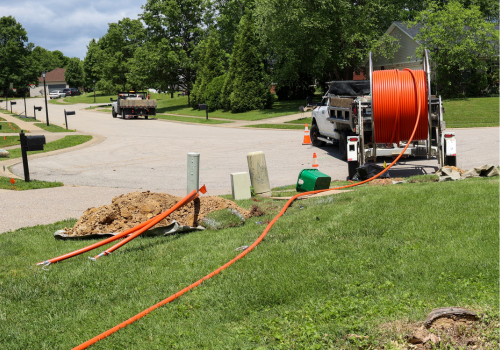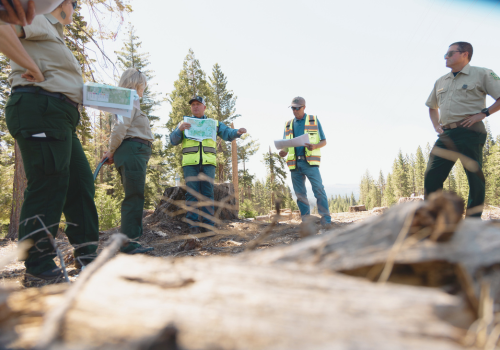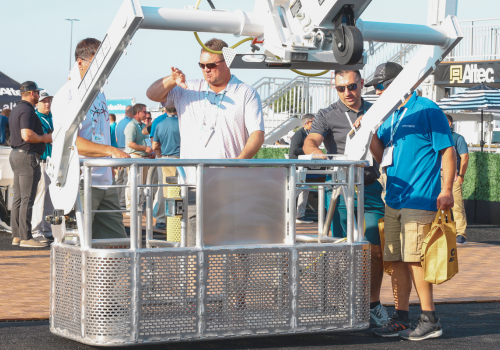The mid-sized excavator (also called the midi excavator) is a popular size for utilities.
“An excavator is a critical machine on most job sites, and the utility market is no exception,” says Justin Steger, solutions marketing manager, site development & underground, John Deere. “From our smallest 75G to the largest 380G in this size class, contractors have plenty of choices to find the right machine for the job. Whether it’s the excavation, assembly, or backfill portion of an underground job, there are key considerations that lend well to these mid-size excavators.”
John Deere classifies mid-size excavators as having a rated operating weight between 7.5 metric tons and 38 metric tons (16,500 pounds and 90,000 pounds).
Machines as versatile as your jobs
Versatility among job tasks is important to keep machine utilization high and total job cost down. From a maintenance job breaking concrete to access the utility or pipe, to lifting and setting trench boxes, to excavating trenches and setting new pipe for assembly, or backfilling, excavators prove themselves in a range of applications.
One key to an excavator’s versatility is its ability to be equipped with numerous attachments. Besides the traditional general purpose bucket, popular excavator attachments used in utilities include hydraulic thumbs, couplers, ditching V buckets, vacuum (for lifting), tilt rotators, grapples, rippers, augers and more.
There is no one excavator type that is going to be perfect for all utility applications or situations. Manufacturers meet these specific needs by developing different kinds of excavators.
John Deere offers conventional tail-swing models (130G, 160G LC, 200G, 210G LC, 250G LC, 300G LC, 350G LC, and 380G LC) for tasks that require power and production. They offer reduced-tail-swing (RTS) models for space-restricted jobs; these are ideal when working within a single lane of traffic or a busy metropolitan area when it’s important to swing within your tracks. John Deere 75G, 85G, 135G, 245G LC, and their latest 345G LC RTS models are increasingly popular due to their versatility, performance, and stability, says John Deere. Wheeled excavators are a popular choice for local governments who perform utility and landscaping work, and John Deere offers a 190GW wheeled excavator. (Model numbers roughly correspond to model weight. For example, the 130G weighs approximately 13,000 pounds.)
One option available to owners of smaller midi excavators is to add a longer arm. Available sometimes from the midi excavator manufacturer or from an aftermarket equipment provider, the longer arm adds approximately two more feet of reach/digging depth. This allows contractors to save capital and transportation costs, since these excavators cost less than a larger unit with the same reach and they can be transported on a flatbed, however the larger sized midi excavator does require a more expensive trailer to haul it.
Taking midi excavators to the next level
Besides the varying types of midi excavators, manufacturers offer technologies and other features that improve efficiency, production, performance, safety, and accuracy.
The most popular technology for utilities or anyone who performs excavation, trenching or earthmoving applications is the use of 2D grade control.
2D grade control allows for precise grades to millimeter accuracy using sensors attached to the excavator. With this technology, the operator uses the machine’s interface and bucket to virtually set a geographical point. From there, the operator can set a dig depth. By selecting two points, the operator can set slope or cross slope data. The interface displays a 2D image of the cutting area, which the operator uses as a reference for achieving grade.
This can be upgraded to 3D grade control. First only available on larger excavators and other larger machine types, this technology is making its way into smaller machine types.
John Deere has recently announced their SmartGrade technology is available on the 210G LC and 350G LC as a factory-installed and factory-calibrated option beginning February 2021.
“SmartGrade enables semiautomatic machine control available for 2D and 3D systems while offering virtual fencing and remote support,” says Steger. “SmartGrade helps an operator get to grade more efficiently by providing real-time information through the in-cab monitor.
The technology deploys a host of features such as over-dig protect, which hydraulically limits the machine from digging beyond the point set. The feature virtual front works in a similar fashion but prevents the machine from reaching beyond the set point. Features such as virtual ceiling, virtual floor, virtual swing, and virtual wall, instead of hydraulically limiting the excavator, provide audible alerts when the machine’s bucket approaches the set point.
Features that use GPS to limit an excavator’s movements are called geo-fencing technologies.
“Whether its virtual fencing, which increases operator awareness of their surroundings, or it’s efficiently digging or maintaining grade to get more pipe in the ground with less periodic grade checks, or over-dig protection to prevent costly rework, these features are all valuable on a utility job site.”
Join thousands of industry peers who receive utility construction industry news and trends each week. Subscribe to The Utility Expo Newsletter.












